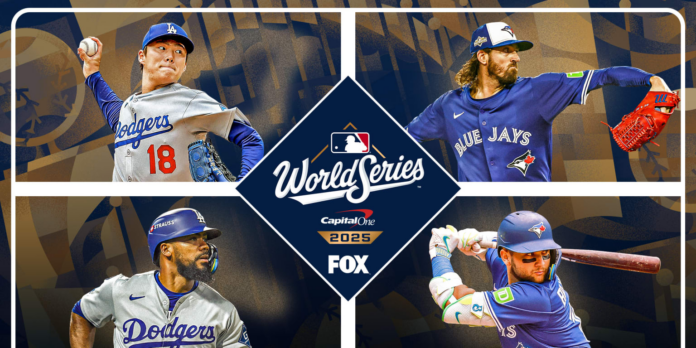The general consensus was that the Dodgers, after winning nine of their first 10 postseason games, with all their MVPs and All-Stars, were going to cruise through this World Series. One could have gotten the impression that the Blue Jays were almost like supporting players in the Dodgers’ victorious story.
That general consensus was, uh, wrong. Thanks to a nine-run sixth inning that broke a 2-2 tie and a raucous crowd that didn’t seem to sit down all night, the Blue Jays lead this series, 1-0. Now they’ve got a chance to put the Dodgers in a serious hole before the series heads back to Los Angeles.
Eight different players had hits for the Blue Jays in Game 1, and the game was marked by the relentlessness of the Jays’ at-bats. The word the broadcast kept using was “grinding,” and their at-bats were a seemingly endless series of foul balls, keeping them in the at-bat, running up the pitch count, before they finally broke through in the sixth. The strategy is a sound one in general — get the starters out of there — but it’s particularly smart when facing the Dodgers.
The reason the Dodgers have been so dominant this postseason is because their starters have been unhittable, but those unhittable starters have disguised the Dodgers’ biggest weakness: the mushy middle of their bullpen. In Game 1, the Blue Jays wore down Blake Snell, with a 29-pitch first inning setting up a short outing in which Snell was pulled with no outs and the bases loaded in the sixth. And once that happened, Toronto pounced, knocking around Emmet Sheehan and Anthony Banda to turn a tight game into a blowout.
The Jays will have their hands full in Game 2 with Yamamoto, who is fresh off a three-hit complete game in the NLCS. Still, the strategy for the rest of the series has now been established. Toronto needs to make Yamamoto throw as many pitches as possible. The earlier they can get him out of the game, even if they haven’t scored many runs off him, the better.
Trey Yesavage was not at his best in Game 1, though it speaks to how excellent he has been that he has only pitched seven big league games in his career and we already have a very clear idea of what his “best” is. He was hesitant to throw his splitter, his best pitch, for most of Game 1, and it gave the Dodgers plenty of opportunities against him. But they didn’t really take advantage of them. Yesavage gave up four hits and three walks in four innings, but ended up allowing only two runs, escaping multiple jams and several Dodgers chances to really pour it on.
It’s unlikely the Dodgers would have scored enough runs to make up for the nine-run sixth inning that ultimately ensued, but then again, there’s no telling which direction the entire game might have taken if L.A. had cashed in some of those early opportunities. If you’ve got a starter off his game as much as Yesavage was in Game 1, you’ve got to do better than two runs.
The Dodgers have a tougher Game 2 assignment against Kevin Gausman, who is fresh off winning Game 7 of the ALCS in relief and has a 2.00 ERA in the postseason so far. He is also someone who has waited 13 years of his career for his World Series debut — unlike, say, Yesavage’s six games — and he is going to be amped up, particularly with that deafening Toronto crowd behind him.
The Blue Jays had an offense that didn’t let up in Game 1. The Dodgers had one that let up far too often … which is exactly why they are currently behind 1-0 in this series.
Game 1 couldn’t have gone much better for Bichette, who hadn’t played since Sept. 6 due to a knee injury. He held up fine at second base, a position he hadn’t played once in his big league career, even making a terrific play up the middle that would seem to require exactly the sort of effort that could have hurt him. He went 1-for-2 at the plate, and he had the leadoff walk in the sixth inning that led to the explosion.
Bichette also was pulled immediately after that walk for a pinch-runner and defensive replacement (Isiah Kiner-Falefa). The Blue Jays couldn’t have asked for more than that in his first game back. Now the question is: How will he bounce back physically for Game 2, after seeing his first game action in seven weeks? And will manager John Schneider follow the same plan for his usage moving forward?
Schneider wants to keep Bichette healthy and in the lineup, and it went perfectly in Game 1. But this is the World Series. It won’t always go this perfectly. We just saw how Bichette, even at less than 100 percent, makes this Blue Jays lineup even more terrifying. But there are still many, many variables here … and many ways this could go wrong.


